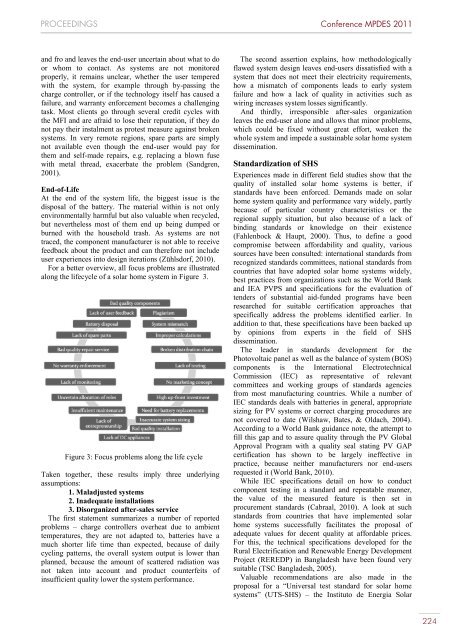Martina Schäfer, Noara Kebir, Daniel Philipp (editors) - TU Berlin
Martina Schäfer, Noara Kebir, Daniel Philipp (editors) - TU Berlin
Martina Schäfer, Noara Kebir, Daniel Philipp (editors) - TU Berlin
Create successful ePaper yourself
Turn your PDF publications into a flip-book with our unique Google optimized e-Paper software.
PROCEEDINGS Conference MPDES 2011<br />
and fro and leaves the end-user uncertain about what to do<br />
or whom to contact. As systems are not monitored<br />
properly, it remains unclear, whether the user tempered<br />
with the system, for example through by-passing the<br />
charge controller, or if the technology itself has caused a<br />
failure, and warranty enforcement becomes a challenging<br />
task. Most clients go through several credit cycles with<br />
the MFI and are afraid to lose their reputation, if they do<br />
not pay their instalment as protest measure against broken<br />
systems. In very remote regions, spare parts are simply<br />
not available even though the end-user would pay for<br />
them and self-made repairs, e.g. replacing a blown fuse<br />
with metal thread, exacerbate the problem (Sandgren,<br />
2001).<br />
End-of-Life<br />
At the end of the system life, the biggest issue is the<br />
disposal of the battery. The material within is not only<br />
environmentally harmful but also valuable when recycled,<br />
but nevertheless most of them end up being dumped or<br />
burned with the household trash. As systems are not<br />
traced, the component manufacturer is not able to receive<br />
feedback about the product and can therefore not include<br />
user experiences into design iterations (Zühlsdorf, 2010).<br />
For a better overview, all focus problems are illustrated<br />
along the lifecycle of a solar home system in Figure 3.<br />
Figure 3: Focus problems along the life cycle<br />
Taken together, these results imply three underlying<br />
assumptions:<br />
1. Maladjusted systems<br />
2. Inadequate installations<br />
3. Disorganized after-sales service<br />
The first statement summarizes a number of reported<br />
problems – charge controllers overheat due to ambient<br />
temperatures, they are not adapted to, batteries have a<br />
much shorter life time than expected, because of daily<br />
cycling patterns, the overall system output is lower than<br />
planned, because the amount of scattered radiation was<br />
not taken into account and product counterfeits of<br />
insufficient quality lower the system performance.<br />
The second assertion explains, how methodologically<br />
flawed system design leaves end-users dissatisfied with a<br />
system that does not meet their electricity requirements,<br />
how a mismatch of components leads to early system<br />
failure and how a lack of quality in activities such as<br />
wiring increases system losses significantly.<br />
And thirdly, irresponsible after-sales organization<br />
leaves the end-user alone and allows that minor problems,<br />
which could be fixed without great effort, weaken the<br />
whole system and impede a sustainable solar home system<br />
dissemination.<br />
Standardization of SHS<br />
Experiences made in different field studies show that the<br />
quality of installed solar home systems is better, if<br />
standards have been enforced. Demands made on solar<br />
home system quality and performance vary widely, partly<br />
because of particular country characteristics or the<br />
regional supply situation, but also because of a lack of<br />
binding standards or knowledge on their existence<br />
(Fahlenbock & Haupt, 2000). Thus, to define a good<br />
compromise between affordability and quality, various<br />
sources have been consulted: international standards from<br />
recognized standards committees, national standards from<br />
countries that have adopted solar home systems widely,<br />
best practices from organizations such as the World Bank<br />
and IEA PVPS and specifications for the evaluation of<br />
tenders of substantial aid-funded programs have been<br />
researched for suitable certification approaches that<br />
specifically address the problems identified earlier. In<br />
addition to that, these specifications have been backed up<br />
by opinions from experts in the field of SHS<br />
dissemination.<br />
The leader in standards development for the<br />
Photovoltaic panel as well as the balance of system (BOS)<br />
components is the International Electrotechnical<br />
Commission (IEC) as representative of relevant<br />
committees and working groups of standards agencies<br />
from most manufacturing countries. While a number of<br />
IEC standards deals with batteries in general, appropriate<br />
sizing for PV systems or correct charging procedures are<br />
not covered to date (Wilshaw, Bates, & Oldach, 2004).<br />
According to a World Bank guidance note, the attempt to<br />
fill this gap and to assure quality through the PV Global<br />
Approval Program with a quality seal stating PV GAP<br />
certification has shown to be largely ineffective in<br />
practice, because neither manufacturers nor end-users<br />
requested it (World Bank, 2010).<br />
While IEC specifications detail on how to conduct<br />
component testing in a standard and repeatable manner,<br />
the value of the measured feature is then set in<br />
procurement standards (Cabraal, 2010). A look at such<br />
standards from countries that have implemented solar<br />
home systems successfully facilitates the proposal of<br />
adequate values for decent quality at affordable prices.<br />
For this, the technical specifications developed for the<br />
Rural Electrification and Renewable Energy Development<br />
Project (REREDP) in Bangladesh have been found very<br />
suitable (TSC Bangladesh, 2005).<br />
Valuable recommendations are also made in the<br />
proposal for a “Universal test standard for solar home<br />
systems” (UTS-SHS) – the Instituto de Energia Solar<br />
224


